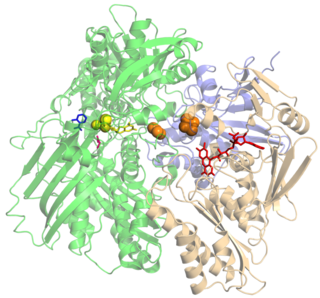
Xanthine oxidase is a form of xanthine oxidoreductase, a type of enzyme that generates reactive oxygen species. These enzymes catalyze the oxidation of hypoxanthine to xanthine and can further catalyze the oxidation of xanthine to uric acid. These enzymes play an important role in the catabolism of purines in some species, including humans.

N,N-Dimethylaniline (DMA) is an organic chemical compound, a substituted derivative of aniline. It is a tertiary amine, featuring a dimethylamino group attached to a phenyl group. This oily liquid is colourless when pure, but commercial samples are often yellow. It is an important precursor to dyes such as crystal violet.
In biochemistry, a lyase is an enzyme that catalyzes the breaking of various chemical bonds by means other than hydrolysis and oxidation, often forming a new double bond or a new ring structure. The reverse reaction is also possible. For example, an enzyme that catalyzed this reaction would be a lyase:

Cytochromes P450 are a superfamily of enzymes containing heme as a cofactor that mostly, but not exclusively, function as monooxygenases. However, they are not omnipresent; for example, they have not been found in Escherichia coli. In mammals, these enzymes oxidize steroids, fatty acids, xenobiotics, and participate in many biosyntheses. By hydroxylation, CYP450 enzymes convert xenobiotics into hydrophilic derivatives, which are more readily excreted.

In biochemistry, flavin adenine dinucleotide (FAD) is a redox-active coenzyme associated with various proteins, which is involved with several enzymatic reactions in metabolism. A flavoprotein is a protein that contains a flavin group, which may be in the form of FAD or flavin mononucleotide (FMN). Many flavoproteins are known: components of the succinate dehydrogenase complex, α-ketoglutarate dehydrogenase, and a component of the pyruvate dehydrogenase complex.
Methylotrophs are a diverse group of microorganisms that can use reduced one-carbon compounds, such as methanol or methane, as the carbon source for their growth; and multi-carbon compounds that contain no carbon-carbon bonds, such as dimethyl ether and dimethylamine. This group of microorganisms also includes those capable of assimilating reduced one-carbon compounds by way of carbon dioxide using the ribulose bisphosphate pathway. These organisms should not be confused with methanogens which on the contrary produce methane as a by-product from various one-carbon compounds such as carbon dioxide. Some methylotrophs can degrade the greenhouse gas methane, and in this case they are called methanotrophs. The abundance, purity, and low price of methanol compared to commonly used sugars make methylotrophs competent organisms for production of amino acids, vitamins, recombinant proteins, single-cell proteins, co-enzymes and cytochromes.

Iproniazid is a non-selective, irreversible monoamine oxidase inhibitor (MAOI) of the hydrazine class. It is a xenobiotic that was originally designed to treat tuberculosis, but was later most prominently used as an antidepressant drug. However, it was withdrawn from the market because of its hepatotoxicity. The medical use of iproniazid was discontinued in most of the world in the 1960s, but remained in use in France until its discontinuation in 2015.
Any enzyme system that includes cytochrome P450 protein or domain can be called a P450-containing system.
Microbial metabolism is the means by which a microbe obtains the energy and nutrients it needs to live and reproduce. Microbes use many different types of metabolic strategies and species can often be differentiated from each other based on metabolic characteristics. The specific metabolic properties of a microbe are the major factors in determining that microbe's ecological niche, and often allow for that microbe to be useful in industrial processes or responsible for biogeochemical cycles.
2-Hydroxyphytanoyl-CoA lyase is a peroxisomal enzyme involved in the catabolism of phytanoic acid by α-oxidation. It requires thiamine diphosphate (ThDP) as cofactor.
Mixed-function oxidase is the name of a family of oxidase enzymes that catalyze a reaction in which each of the two atoms of oxygen in O2 is used for a different function in the reaction.

In enzymology, an alliin lyase is an enzyme that catalyzes the chemical reaction
The enzyme S-(hydroxymethyl)glutathione synthase catalyzes the reaction
The enzyme 2-dehydropantoate aldolase catalyzes the chemical reaction:
The enzyme ketotetrose-phosphate aldolase catalyzes the chemical reaction
The enzyme trimethylamine-oxide aldolase catalyzes the chemical reaction

The enzyme 6-pyruvoyltetrahydropterin synthase catalyzes the following chemical reaction:
Methylsterol monooxygenase (EC 1.14.13.72, methylsterol hydroxylase, 4-methylsterol oxidase, 4,4-dimethyl-5alpha-cholest-7-en-3beta-ol,hydrogen-donor:oxygen oxidoreductase (hydroxylating)) is an enzyme with systematic name 4,4-dimethyl-5alpha-cholest-7-en-3beta-ol,NAD(P)H:oxygen oxidoreductase (hydroxylating). This enzyme catalyses the following chemical reaction
Hydro-lyases are a type of enzyme. As lyases, hydro-lyases cleave various chemical bonds by means other than hydrolysis and oxidation. Examples of specific hydro-lyases include carbonic anhydrase and fumarase.

Methyl violet 6B is a violet triarylmethane dye from the group of cationic dyes and an essential component of C.I. Basic Violet 1. The compound is sometimes equated with methyl violet in the literature.








